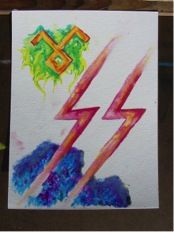
Environment
The Power of Art in Crossing Inmates’ Prison Boundaries
An art therapy prison group helps bring together opposing inmates
Posted January 8, 2015
Many years ago, a close friend and colleague, Lariza Fenner, attended the Florida State University’s graduate art therapy program. While here, she completed her art therapy internship and conducted her own research at a local men’s prison. During this time, we wrote an article about boundary issues an art therapy intern may face while working in prison: "Therapeutic boundaries in a prison setting: A dialogue between an intern and her supervisor" (this article can be found here)
She has since moved on, and has made her own profound mark on the field. Until recently, Lariza was a member of the Core Faculty at the Adler School of Professional Psychology in Chicago. She also provides a great deal of service to state and national professional organizations including President-Elect of the Illinois Art Therapy Association and President of the Coalition of Illinois Counselor Organizations.
As well, as Lariza points out, “I also enjoys engaging in ceramic arts and I am an avid Jiu Jitsu practitioner.”
While I was in Chicago last fall, she and I began reminiscing about her work in the prisons. While bantering about some of the challenges and successes she experienced, she reminded me of a particular case that became the focus of some of our supervisory discussions. I am pleased that Lariza agreed to write about it as this post’s guest blogger.
Transforming Prison Boundaries: The Power of Art
by Lariza Fenner, ATR, NCC, LCPC

When I look back on my experiences working in the prison in North Florida prison, I think about the times when art best expressed the inter-subjective dynamics in the room, including the various boundaries that existed between the inmates. While the boundaries at the prison—between the inmates and with the staff--fluctuated from rigid to diffuse constantly, they were mediated by the art process.
Boundaries are what transpires in the inter-subjective space as we co-create events and experiences with others. This was the main event in the group therapy room as the issues that each member carried entered into this shared space. As I interacted with the group as a leader, there were inevitable transgressions and projections.
Sometimes these were minor, like when an inmate mentioned how I reminded them of their mother or sister, how my shoes surely signified that I am “sporty,” or that my music revealed the particular social group I was a part of. By doing so, they were trying to enter into my psychological space and intimately engage in meaningful conversation.
This was fine until the boundary of time—believe it or not, an important one for the prison to maintain consistency and security-- was broken and I stayed five minutes after the session to listen to further explanations about their work and their current status or lead offense. In the prison system, once you transgress a boundary like time you open the floodgates--ultimately I became their confessor.
Other boundaries developed among inmates, necessary for their survival. These were pre-established, ones that I could not always change—nor should I have-- through art therapy.
Social group affiliation oftentimes dictated the emotional and psychological vulnerabilities and distances among and between members. And yet, sometimes, the art allowed for true expression and crossing these thick barriers.
The following vignette showcases just such a time when the art process acted as mediator of difference and facilitator of group interaction.
Jake
Art therapy sessions were held in a closed, hot and poorly constructed room in the prison, crowded with furniture, supplies and various other ephemera.
Jake was among six other men in my art therapy group. He stood out, in particular because he had a tattoo of a swastika in the middle of his forehead. He was serving a life sentence. I instantly feared the ramifications of his overt neo-Nazi identification, as two African American men entered the room right after Jake. Once seated, one of the men turned his chair so his back was to Jake; he did not care to look at his face, let alone acknowledge his presence.
This is Jake’s first piece-- an inside-outside box:


At this point I took a deep breath and hoped that I would not see a fight, that the art could possibly bypass some of the potentially pathological boundaries in the room.
I offered directives that would slowly acclimate the men to the group expectations and to each other. I used paper as a sculptural material to allow for experimentation and freedom. There was a poetry pass, ripped paper exercises, free drawing along with other art directives.
Along the way, tension lessened and the inmates seemed to develop an overt agreement that they would leave their “social affiliations” on the yard and engage with each other while in the group.
They acknowledged the art process as an enjoyable “escape” from their normal routine.
It was more than I expected.
Despite this, some would still focus on their associations with other offensive groups. In his personal symbol work, Jake continued to use neo-Nazi motifs:

I saw this as a simultaneous need to distance himself from others while belonging to a group for protection. However, in some of his drawings he stayed away from the offensive symbols:
This image, with the world on fire, represents chaos.

Jake was eventually able to metaphorically step outside the group with which he usually his affiliates with and addressed his inner turmoil with the group.
As the group neared the end, in an effort to improve group interaction, I reminded the group members of the self-symbol drawings they drew early on, offered them Sculpey (air-hardening clay) to sculpt their symbols, and asked them to place all of the sculptures on large mural paper. I then asked them to create an environment around them.
Jake abandoned the SS symbol for an abstract form [it was unclear what it was; he did not care to elaborate on it]. He placed his form in the very center upon an earth shape surrounded by barbed wire. He was simultaneously transforming his identity while remaining guarded—a healthy place to be in prison.

The group as a whole related much better to one another on the page as several of the inmates attempted to traverse the inter-subjective space to meet each other through the interaction of their sculpted self-symbols. Ultimately, the men were able to create a piece that symbolized the ability to address differences and continue to interact well together.
The final piece, created jointly by all group participants, illustrates the power of art therapy. Through the group experience, rigid boundaries were safely crossed, albeit tentatively. Prisoners now had the means to communicate across ingrained social boundaries and self-concepts. As the lead art therapist, I was proud to facilitate this evolution.




